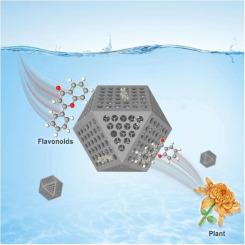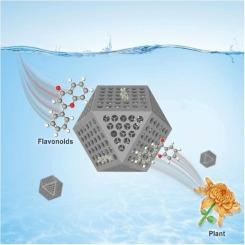用于高效吸附植物提取物中黄酮类化合物的三维有序大孔掺氮碳
IF 13.2
1区 工程技术
Q1 ENGINEERING, CHEMICAL
引用次数: 0
摘要
为了满足生物制药行业的需求,开发用于植物提取物中黄酮类化合物分离的高级吸附剂具有重要意义。在此,我们设计并制作了一种具有三维有序大孔结构(3DOM NC)的氮掺杂碳吸附剂,用于吸附类黄酮。实验和密度泛函数理论结果表明,有序的大孔结构使3DOM NC具有高效的传质性能和较高的吸附位点可达性,而碳质骨架中的n种促进了黄酮类化合物的化学吸附。结果表明,3DOM NC对芦丁(黄酮类化合物中的一种)的吸附能力是前所未有的,最大平衡吸附量为536.91 mg/g。值得注意的是,3DOM NC表现出比商业吸附剂(如大孔树脂)更高的吸附能力,因此可以作为一种有效的吸附剂,用于从植物(如洋甘菊)提取液中分离黄酮类化合物。本文章由计算机程序翻译,如有差异,请以英文原文为准。


Three-dimensional ordered macroporous nitrogen-doped carbon for efficient adsorption of flavonoids from plant extraction
The development of advanced adsorbents for the separation of flavonoids from plant extraction is of great importance in order to meet the demand of bio-pharmaceutical industries. Herein, we designed and fabricated a nitrogen-doped carbon adsorbent with 3D ordered macroporous structure (3DOM NC) towards the adsorption of flavonoids. Experimental and density functional theory results demonstrate that the ordered macroporous structure endows 3DOM NC with efficient mass transfer and high accessibility of adsorption sites, while the N-species in the carbonaceous skeleton can promote the chemisorption of flavonoids. As a result, 3DOM NC shows unprecedent capability in the adsorption of rutin (one kind of flavonoids), affording a maximal equilibrium adsorption amount of 536.91 mg/g. Remarkably, 3DOM NC exhibits much higher adsorption capacity than commercial adsorbents (e.g., macroporous resins) and thus can be served as an efficient adsorbent for the separation of flavonoids from the plant (e.g., chamomile) extraction fluid.
求助全文
通过发布文献求助,成功后即可免费获取论文全文。
去求助
来源期刊

Chemical Engineering Journal
工程技术-工程:化工
CiteScore
21.70
自引率
9.30%
发文量
6781
审稿时长
2.4 months
期刊介绍:
The Chemical Engineering Journal is an international research journal that invites contributions of original and novel fundamental research. It aims to provide an international platform for presenting original fundamental research, interpretative reviews, and discussions on new developments in chemical engineering. The journal welcomes papers that describe novel theory and its practical application, as well as those that demonstrate the transfer of techniques from other disciplines. It also welcomes reports on carefully conducted experimental work that is soundly interpreted. The main focus of the journal is on original and rigorous research results that have broad significance. The Catalysis section within the Chemical Engineering Journal focuses specifically on Experimental and Theoretical studies in the fields of heterogeneous catalysis, molecular catalysis, and biocatalysis. These studies have industrial impact on various sectors such as chemicals, energy, materials, foods, healthcare, and environmental protection.
 求助内容:
求助内容: 应助结果提醒方式:
应助结果提醒方式:


